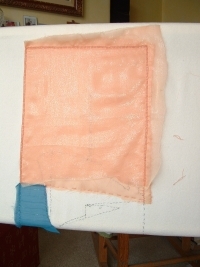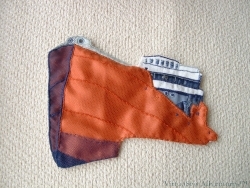The Camberwell Panel – Six
I finally decided that I wanted to use two layers of gauze for the sky. The apricot gauze has a slightly reflective surface, which would make the sky glow behind the ship.
I also worked blanket stitch around the outside edge of the panel. At this stage I intended to use a raised band stitch of some sort to frame the work, so the blanket stitch was to form the foundation of the final raised band.
Later I was to discover that the Camberwell herself had Other Ideas, and all of this was completely changed.
I think it is important to show some of the dead ends I investigated here, or at least to describe them. One thing that people who are at the early stages of their creative life always assume is that everyone else gets straight from “Germ of an Idea” to “Finished Design” without really passing through any points in between.
We don’t.
Any of us.
And we are not fair to them – and risk discouraging them – if we allow them to think that we do.
Oops. Rant over!
This next photo shows further progress on the slip for the hull, in which I worked on the superstructure of the bridge and living quarters. I pierced the cotton drill where the anchor chains are lead through the hull and worked one of the portholes on the bridge in a raised satin stitch boss. Almost all the actual embroidery here used ordinary stranded cotton, although sometimes I blended colours in the needle.



plenty of mistakes happen here too, or should I call them ”learning experiences”. They are actually invaluable, they help in so many ways especially for future projects. A mistake can actually become a project of its own.
The process is often just as, sometimes more, important than the end product.
The slip looks *fantastic*. Can tell boats run in your family! 🙂
Have you any more to say about using the apricot gauze as a background? You know I tried organza as a ground (with backing) and it completely defeated me – ‘runs’ like stocking runs when I stitched. Is ‘gauze’ woven differently to ‘organza’?
Chilly Hollow Adventures (which includes a reference to an article by Gay Ann Rogers) talks about the design process in the last couple of posts. Tho in the context of choosing stitches for painted canvases, it is sort of relevant in that they talk about the different approaches people take to their decisions.
the process is just as important as the end result. And sometimes more interesting!
That hull looks wonderful – as if I’m looking at it in 3D!
It was about this stage (and after a visit to see the Work In Progress) that I could carry in my mind a true idea of the colours and a good impression of the finished piece. The photo of the Slip is a very good colour representation, particularly of the terracotta which really glows especially first thing in the morning.
The house now decided that by virtue of the size and colours there was only one place to hang the completed panel and that was on the oposite side of the door where the framed photo of the original is hanging, above the radiator next to the window in… and I’m saving the rest for the Big Reveal at the end!
I’m wondering if you had begun to wish by this stage that this was going to be for you! Looking great, and so realistic.
The ship is coming along just beautifully! Like the client, I can now see how things will look in the finale. And, yes, mistakes and trial and error are at the heart of any design work. We may be able to see how we want a piece to look, but getting there isn’t always a straight line.